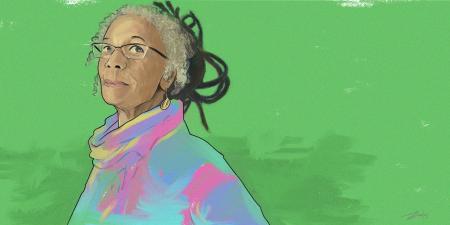Abstract
Abolition medicine and reproductive justice are synergistic approaches that advance a radical vision of a racially just world. Abolition medicine and reproductive justice push medical and carceral systems towards a focus on the structural factors that impede safe and dignified parenting and childrearing, bodily autonomy, and sexual and reproductive health. Persons experiencing incarceration are stripped of authority over their health decisions, bodily autonomy, and freedom, with major implications for their well-being, sexuality, and reproduction. Black and Brown individuals and communities, who are disproportionately affected by mass incarceration and health disparities, are most in need of abolitionist reproductive justice. This article urges abolitionist clinicians to interrogate the health care sector’s relationships with carceral systems and reproductive oppression.
Case
We get locked down at 10 o’clock. It wasn’t until twelve before anybody came. And when they opened the door, there was blood everywhere. So, the gush that I felt was blood. They were looking at me like I was an alien. Nobody wanted to touch me. They were like, “Oh, can you walk?” I remember being furious, scared, angry, and crying, “No. I’m not walking down those steps. I’ve been asking you to move me for months.” A few minutes later, the men brought a stretcher and took me out. They were debating whether to call 911 or the marshals, so at this point, I’m afraid not only for my baby but for my own life. I was hemorrhaging. I was like, “You need to get me out of here. Please call 911.”
Commentary
The above quotation is an excerpt from an interview that the first author (C.H.) conducted with Beverly (not her real name), a Black woman who was formerly incarcerated and had a tragic and frightening miscarriage in jail. Despite being visibly pregnant, Beverly was shackled around her wrists, belly, and ankles during a trip to court. The shackling made it very difficult to walk. As she tried to enter the jail van, she fell; her jailers watched and did nothing. Shortly thereafter, she began spotting and bleeding. For weeks after the fall, she pleaded to see a doctor—pleas that were ignored. By the time she was moved to the hospital, it was too late. She miscarried. When Beverly’s doctors asked to see the sheets where she hemorrhaged, the same prison officials who ignored Beverly for hours informed them that the sheets had been thrown away. Beverly was devastated: those sheets represented the baby she lost, the baby that she desperately wanted to survive. As she explained to the first author, the entire experience was dehumanizing: “It felt like they threw a piece of me in the trash, like it was nothing.”
Beverly’s story highlights how racial and reproductive violence are perpetrated through the US carceral system1,2,3 and health care’s embedment in the carceral system.4 In this essay, we suggest that the US health care industrial complex has an important opportunity to reckon with its complicity and active engagement in perpetuating mass incarceration5 and its threats to reproductive justice (RJ). We argue that the centering of RJ within the abolition medicine framework is an emancipatory intervention for people experiencing incarceration, particularly to address reproductive violence like that inflicted upon Beverly. Such a paradigm shift away from complicity toward addressing the conditions that perpetuate reproductive rights violations will not only serve to restore patients’ bodily autonomy and authority over their health decisions but also inspire interrogation of the relationship between carceral institutions and medicine, particularly with respect to reproductive health care for the most vulnerable members of our society.
Incarceration
In 1994, Black women activists coined the term reproductive justice.6 These activists developed RJ as a human rights counterweight to President Bill Clinton’s proposed universal health care plan7 that deemphasized crucial reproductive and sexual health care and the White-led prochoice movement’s narrow focus on privacy and choice in relation to abortion—a focus that erased the primacy of structural oppression and White supremacy in constraining reproductive freedom for communities of color. RJ has grown beyond a social movement to become a value system for organizing society with respect to 4 major tenets: the right to have children, the right not to have children, the right to parent safely and with dignity, and the right to bodily autonomy.6 In other words, RJ makes clear that any system or institution that impedes these rights and individuals’ capacity to make healthy decisions about their reproduction and sexuality is a violation of human rights.
Beverly’s barbaric mistreatment reflects how the US carceral system and its institutions, practices, and policies have legitimized and even normalized the violation of people’s reproductive and bodily self-determination. For example, it is not uncommon for pregnant women who are incarcerated to be dangerously shackled to their beds during childbirth, where they are forced to labor alone, and have their newborn infants stripped from them almost immediately after childbirth.3 Scholars are beginning to identify the carceral system as a major threat to RJ in our society.1,8,9
Jails and prisons represent the most extreme arm of the state’s control over people’s bodies. Mass incarceration occurs when a disproportionate segment of the population is locked up in prisons, jails, and detention facilities as a response to social problems.1 Mass incarceration in the United States is well understood to have roots in settler colonialism, White supremacy, racism, sexism, and capitalism.10,11,12 From its inception, the US criminal legal and carceral systems disproportionately targeted and brutalized Black and Brown communities, people living in poverty, the undocumented, people with disabilities, and queer communities—the very communities that are blamed (and therefore criminalized) for social problems ranging from poverty to health disparities.
Abolition medicine questions power and the structures and systems that enable violence and create racial health inequities.
Mass incarceration and the entire carceral regime have helped to engineer a society in which people who are incarcerated are stripped of their reproductive self-determination and dignity. From the over-policing and surveillance of Black and Brown communities that rob people of reproductive autonomy (eg, fetuses defined as persons under the law and the criminalization of stillbirth, miscarriage, self-managed abortion, and drug use)13 to the denial of a safe and healthy pregnancy and the disruption of parenting for people who are incarcerated, mass incarceration poses an expansive and durable system of reproductive oppression.1,10 As recently as 2020, doctors were exposed for engaging in coercive and forced sterilization practices at an immigration detention center,14,15 reflecting a long pattern of reproductive violence and abuse against people under state control. Similarly, from 1997 to 2010, prison medical staff engaged in coercive sterilization practices at women’s state prisons in California.9
Reproductive Justice and Abolition
The abolitionist framework is a set of ideas and a value system that helps build a racially just and free society. Like the abolitionist movement during slavery, prison abolition today is grounded in a vision of a radically different world, one where all people are afforded the resources to live a life with dignity. For abolitionists, this includes a world free from all forms of violence and control, including violence perpetuated by state actors and institutions—whether the focus is slavery or prisons and jails.
By extension, abolition medicine is the idea that our health care system has a moral, ethical, and professional obligation to use its social powers to interrogate and disrupt systems with a history of harming people. In this way, abolition medicine is deeply embedded in the Black radical tradition and emancipatory strategies and struggles dating back to slavery. Abolition medicine questions power and the structures and systems that enable violence and create racial health inequities—and especially questions their impact on those who have been historically and systematically marginalized.16 Most importantly, as Ruth Wilson Gilmore, founding member of the national grassroots prison abolitionist organization Critical Resistance, put it: prison abolition is not just the absence of prisons but the presence of “vital systems of support that every community needs.”17
Aligning RJ with abolition medicine must begin with the understanding that reproductive self-determination is ultimately racialized (and intersects with other forms of systematic marginalization) to dismantle barriers to access to reproductive care. In this way, the RJ framework is critical for people experiencing incarceration, who are disproportionately from poor, working-class communities of color.18 Abolition medicine is uniquely positioned to protect the human rights of incarcerated people, particularly pregnant women who are incarcerated, via its alignment with RJ. For abolition medicine to work towards creating a world where RJ shapes our society, it will have to focus on 3 main goals: (1) abolishing the entire prison industrial complex, (2) uprooting White supremacy and racism in health care, and (3) ensuring that pregnant people who are incarcerated have access to a full range of high-quality reproductive, sexual, and maternal health services. In other words, aligning RJ with abolition medicine requires health care practitioners to reimagine their role within prison systems and to leverage their power to support the fights to end mass incarceration and the criminalization of pregnancy.
Aligning RJ with abolition medicine would advance a radical vision that moves health care away from systems of control and punishment in which far too many health care and social service professionals have internalized the goals of an anti-Black repressive system. Thus, we strongly urge abolition medicine practitioners to align with the RJ movement in solidarity with Black Lives Matter—and Black women in particular—to address the gender implications of mass incarceration, as exemplified by the treatment of pregnant people who are incarcerated like Beverly, especially the increasing criminalization of pregnancy. Doing so will help to protect women like Beverly from the brutal reproductive violence that has been normalized in the carceral system,19 where the incarceration rate is almost twice as high for Black women as White women.20 It will also help to address health issues that primarily affect Black women21 but go unaddressed because of racial bias within health care. For example, Black women die at a much higher rate than any other group from pregnancy-related complications.22 Yet their experiences are often erased. To quote the Combahee River Collective: “If Black women were free, it would mean that everyone else would have to be free since our freedom would necessitate the destruction of all the systems of oppression.”23
Iwai, Khan, and DasGupta assert: “Abolition medicine is a practice of speculation, of dreaming of a more racially just future and acting to bring that vision to fruition.”16 Abolition medicine imagines a racially just future and health care system. For this future to be reproductively just, health care practitioners must be trained to apply the framework of abolition RJ, both to provide high-quality sexual and reproductive health care and to disrupt institutional practices and structural factors that drive health inequity—and health care’s relationship with mass incarceration. To do so will require interrogation of the health care system with respect to racially unjust practices and policies (eg, drug testing) that lead to the policing and surveilling of systematically marginalized Black and Brown communities (eg, punitive treatment of pregnant women who test positive for drugs).24 Moreover, it will require that we center free and accessible comprehensive reproductive health care and technologies so that all people, particularly those who have been marginalized (eg, people who are incarcerated, people living in poverty, and people with disabilities) are empowered to control their own reproduction and destinies free from stigma, violence, and coercion.
References
- Hayes CM, Sufrin C, Perritt JB. Reproductive justice disrupted: mass incarceration as a driver of reproductive oppression. Am J Public Health. 2020;110(suppl 1):S21-S24.
- Allen SA, Wakeman SE, Cohen RL, Rich JD. Physicians in US prisons in the era of mass incarceration. Int J Prison Health. 2010;6(3):100-106.
-
Sufrin C. Jailcare: Finding the Safety Net for Women Behind Bars. University of California Press; 2017.
- Reverby SM. Can there be acceptable prison health care? Looking back on the 1970s. Public Health Rep. 2018;134(1):89-93.
- Wildeman C, Wang EA. Mass incarceration, public health, and widening inequality in the USA. Lancet. 2017;389(10077):1464-1474.
-
Ross L, Solinger R. Reproductive Justice: An Introduction. University of California Press; 2017.
-
Williams V. Why Black women issued a public demand for “reproductive justice” 25 years ago. Washington Post. August 16, 2019. Accessed October 27, 2021. https://www.washingtonpost.com/nation/2019/08/16/reproductive-justice-how-women-color-asserted-their-voice-abortion-rights-movement/
- Paltrow LM. Roe v Wade and the new Jane Crow: reproductive rights in the age of mass incarceration. Am J Public Health. 2012;103(1):17-21.
- Roth R, Ainsworth SL. “If they hand you a paper, you sign it”: a call to end the sterilization of women in prison. Hastings Womens Law J. 2015;26(1):7-49.
-
Roth R. “She doesn’t deserve to be treated like this”: prisons as sites of reproductive injustice. Center for Women Policy Studies; 2012. Accessed January 20, 2022. https://www.prisonpolicy.org/scans/CWPS_Roth_Reproductive_Injustice_7_13_2012.pdf
- Gillespie K. Placing Angola: racialisation, anthropocentrism, and settler colonialism at the Louisiana State Penitentiary’s Angola Rodeo. Antipode. 2018;50(5):1267-1289.
-
Davis AY. Abolition Democracy: Beyond Empire, Prisons, and Torture. Interviews With Angela Y. Davis. Seven Stories Press; 2005.
- Daniels C, Munsch CL. Pregnancy criminalization, reproductive asymmetry, and race: an experimental study. Fem Criminol. 2018;13(5):560-582.
-
Treisman R. Whistleblower alleges “medical neglect,” questionable hysterectomies of ICE detainees. NPR. September 16, 2020. Accessed October 27, 2021. https://www.npr.org/2020/09/16/913398383/whistleblower-alleges-medical-neglect-questionable-hysterectomies-of-ice-detaine
- Palomo EB, Andersen AW, Mikkelsen CB. Forced sterilization of immigrant women in US detention center. Interdiscip J Int Stud. 2021;11(1):52-63.
- Iwai Y, Khan Z, DasGupta S. Abolition medicine. Lancet. 2020;396(10245):158-158.
-
Gilmore RW. Golden Gulag: Prisons, Surplus, Crisis, and Opposition in Globalizing California. University of California Press; 2007.
-
Sawyer W. Visualizing the racial disparities in mass incarceration. Prison Policy Initiative blog. July 27, 2020. Accessed October 27, 2021. https://www.prisonpolicy.org/blog/2020/07/27/disparities/
- Gross KN. African American women, mass incarceration, and the politics of protection. J Am Hist. 2015;102(1):25-33.
-
Bronson J, Carson EA. Prisoners in 2017. Bureau of Justice Statistics, US Department of Justice; 2019. Accessed November 23, 2021. https://bjs.ojp.gov/content/pub/pdf/p17.pdf
-
Dyer L, Hardeman R, Vilda D, Theall K, Wallace M. Mass incarceration and public health: the association between black jail incarceration and adverse birth outcomes among black women in Louisiana. BMC Pregnancy Childbirth. 2019;19:525.
- Howell EA. Reducing disparities in severe maternal morbidity and mortality. Clin Obstet Gynecol. 2018;61(2):387-399.
- Combahee River Collective. A Black feminist statement. Womens Stud Q. 2014;42(3-4):271-280.
- Metzl JM, Roberts DE. Structural competency meets structural racism: race, politics, and the structure of medical knowledge. Virtual Mentor. 2014;16(9):674-690.



